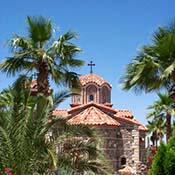
After Jesus’ resurrection, his followers traveled to spread his teachings. One prominent leader in the early church, The apostle Paul, made the radical shift to evangelize the Gentiles (non-Jews), which advanced the global spread of Christianity as more people joined the community of Christ-followers that is the church.
Fifty days after the resurrection of Jesus, the disciples were together in Jerusalem for the Jewish spring harvest festival of Shavuot. There, with people gathered from many lands, the new community of Christ-followers experienced an outpouring of the Holy Spirit. The New Testament describes tongues of fire settling on their heads, enabling them to understand one another and speak the good news of Jesus in all the languages on Earth (Acts 2:4). It was an experience of empowerment which transformed a fearful and somewhat confused group of disciples into apostles, those who are sent to give testimony to their faith (apostolos means "messenger" in Greek). That day became known as Pentecost to Christians and is celebrated as the “birthday of the Church.” The Acts of the Apostles, a book of the New Testament written toward the end of the 1st century by the same author as the Gospel of Luke, tells the story of the early church beginning with this event.
The conversion of a Jewish tentmaker named Saul also fueled early church expansion. According to the Acts of the Apostles, Saul had been a persecutor of Christians until he saw a blinding light from heaven and heard the voice of Jesus as he traveled on the road from Jerusalem to Damascus. This experience convinced him to be baptized as a Christian. For the rest of his life, he traveled the Mediterranean world nurturing small communities of Christians until he finally brought the gospel to Rome. He spoke in synagogues and to communities of Jews, affirming his faith in Christ as Messiah. However, he also spoke to Gentiles—those who were not Jews—because he believed that the message of new life in Christ was not for his people alone, but for women and men everywhere. As an apostle to the Gentiles, he is known by the Roman form of his name, Paul.
Paul’s controversy with the apostle Peter and the community in Jerusalem was of utmost importance for early Christianity, as the movement gradually became differentiated from its Jewish roots. Paul insisted that new Greek converts need not first become circumcised Jews and keep Jewish food and calendrical law in order to become Christians. In this he disagreed with Peter, whom he understood to be the apostle to the Jews. A council in Jerusalem (about 50 CE) decided in agreement with Paul: Gentiles could become Christians just as they were, without becoming circumcised Jews first. With this, the door was opened for a new, more inclusive kind of Christian community. Paul’s letters to the new churches of the Hellenistic world have become an integral part of the New Testament.
The Christian community is called the “church.” The word in Greek is ecclesia, meaning those who were “called out.” It signifies how Christians were called out of their former lives and into a new community. The Acts of the Apostles (2:44-47) describes the life of the first Christian community: “All who believed were together and shared all things in common, sold their possessions and goods and distributed them to all, as any had need. And day by day attending temple together, breaking bread in their homes, they partook of food with glad and generous hearts, praising God and having favor with all the people. And the Lord added to their number day by day those who were being saved.”
In its largest sense, the church is the universal community of all people who profess faith in Christ. The term “catholic” with a lowercase "c," simply means “universal.” In its most intimate sense, the church is any place where “two or three are gathered” in the name of Christ (Matthew 18:20). Whether universal or a small gathering, the church is a community of people. The depictions of community in the New Testament include powerful, organic images of belonging. Most importantly, the church is described as “the body of Christ.” As Paul puts it, “For just as the body is one and has many members, and all the members of the body, though many, are one body, so it is with Christ” (I Corinthians 12:12). Not all parts of the body of Christ, the church, have the same function, but all are members, both suffering and rejoicing together. This powerful metaphor is extended through the central ritual of the community: the blessing and sharing of bread and wine, sometimes referred to as Communion, the Lord’s Supper, or the Eucharist. The bread is called the “body of Christ,” and the wine the “blood of the covenant.” Just as the bread and wine are one, those who share them affirm their oneness (I Corinthians 11:23-25; Matthew 26:26-28).
Through the preaching of Paul and other missionaries, the new Christian faith grew quickly, spreading throughout the Mediterranean world. Its primary competitor was neither the sects nor mysterious religions of ancient Greece and Rome, but the cult of the emperor, who all were required to honor. For Christians, the “Lord” was Christ alone which made worshiping the emperor as Lord impossible. The refusal of the new Christian community to participate in the cult of the emperor made it seem subversive. Throughout the Roman empire, Christians were persecuted and martyred for their faith However, early in the 4th century, the Christian experience was significantly altered when Emperor Constantine himself became a Christian. With his reign, Christianity was not only legalized, but established as the official religion of the Empire.